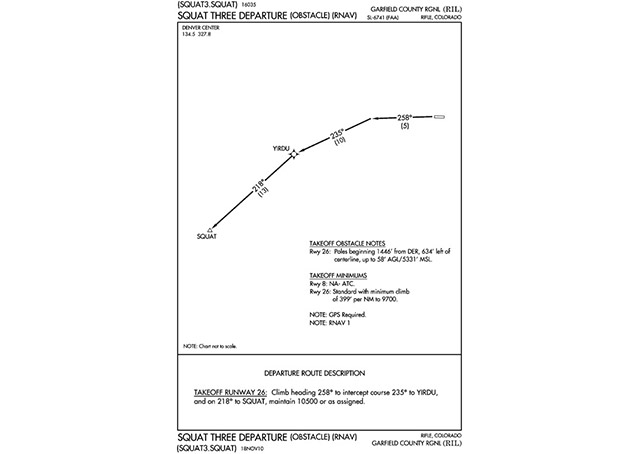
Little-known methods for departing IFR at airports with close-in obstructions
IFR departures can be stressful, especially when low ceilings and visibilities coexist with nearby terrain or obstacles. That’s when you’ll have to break out your approach books to scope out any obstacle departure procedures (ODPs) that apply to the airport and runway you’ll be using. And, right up front, let’s stipulate that we’re talking about ODPs in this article—not the standard instrument departures (SIDs) or departure procedures (DPs) that are more familiar to most of us.
The first thing to know about ODPs is that they are published for airports with instrument approaches, and are for use when obstructions penetrate the obstacle clearance surface, an imaginary plane that rises from the departure end of the runway (DER). That surface rises from the DER at a rate of 152 feet per nautical mile; by two nautical miles from the DER the surface is 304 feet high. This is the main reason that SIDs and DPs require a minimum climb gradient of 200 feet per nautical mile after takeoff. By the way, 200 feet per nautical mile isn’t a big deal. A look at a table that plots rate of climb against groundspeed shows that at a 100-knot groundspeed, you’d need a climb rate of just 333 fpm to realize a 200-foot-per-nm climb gradient.
However, close-in obstructions mean that you may need a climb rate higher than that, and you also may have to maneuver away from the extended runway centerline—or even away from the direction of your first en route fix—to comply with an ODP. Considering that so many airports with ODPs are in mountainous areas, can you still beat that 333 fpm? In hot, high, and heavy conditions you’ll want to run the numbers on the climb rate charts in the performance section of your pilot’s operating handbook or airplane flight manual to find out for sure.
How do you know whether there are any ODPs at your departure airport? You probably know that a “T” inside an inverted black triangle on an approach plate’s briefing strip indicates nonstandard takeoff minimums. It also can mean that there is an obstacle departure procedure. To find it, go to the front of the FAA approach plate book and look up the airport in the “Takeoff Minimums and Obstacle Departure Procedures” section. You’ll see the ODP in text form. Rarely, the ODP will be published in graphic form, along with the other DPs. On Jeppesen charts, text ODPs are on the back of the first, 11-1 approach plates.
What if ATC doesn’t include an ODP or DP in your clearance? Then it’s up to you to follow the procedure of your choice. And if an ODP is published, then you know which choice to make. We all know that FAR Part 91 operations don’t require us to adhere to takeoff minimums, but following them is sound practice indeed. That goes double if a complicated DP or ODP is published.
After following the procedure it will be up to you to navigate to the first en route fix in your flight plan. No radar coverage at your departure airport? That certainly would make for some extra tension. Here’s hoping that ATC can see you right after takeoff and begin issuing further clearance instructions, but in remote areas radar services may not be available until you climb to altitude. You can, and should, take the initiative and try calling them on the frequencies published on the approach plates—as soon as the airplane is cleaned up, climbing, and starting the procedure.
Are there potential traps? Certainly. Pilots not savvy about departure or arrival procedures may simply enter “no SIDs or STARs” in the remarks section of the flight plan, and then assume that ATC will take care of the ODP, in a radar or nonradar environment. Not necessarily so. Plus, ODPs are hard to find, and most are in text form. Pilots may not even think to look for them in the first place. They’ve been called the best-kept “non-secrets” in flying, and are almost never assigned by ATC. Worst of all, a pilot not knowing about ODPs may take off and head directly to that first en route fix in the flight plan, then hit a mountain—never knowing that the ODP would have him going away from that fix. It’s happened.
Email [email protected]



